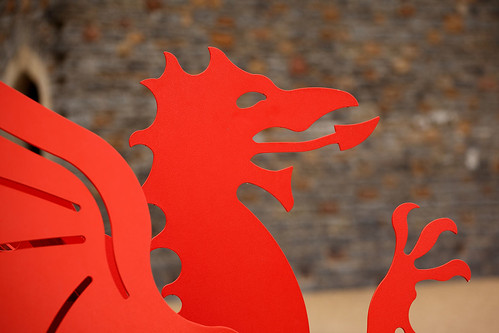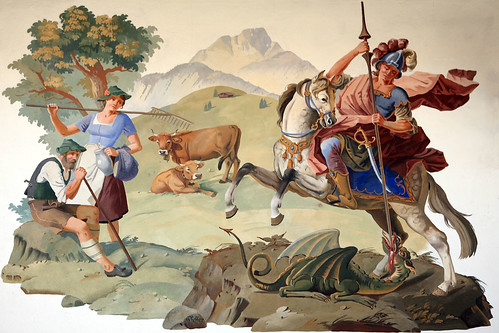

| Archive Blog Cast Forum RSS Books! Poll Results About Search Fan Art Podcast More Stuff Random |
|
Classic comic reruns every day
|
1 {photo of a dragon}
1 Caption: Dragons
|
First (1) | Previous (3307) | Next (3309) || Latest Rerun (2876) |
Latest New (5380) First 5 | Previous 5 | Next 5 | Latest 5 Annotations theme: First | Previous | Next | Latest || First 5 | Previous 5 | Next 5 | Latest 5 This strip's permanent URL: http://www.irregularwebcomic.net/3308.html
Annotations off: turn on
Annotations on: turn off
|
 Dragon Hill - the flat topped region at middle right, just before the line of trees. |
You can visit Dragon Hill today and walk on the very spot, but unless you know the legend and its association with this place, you would never think it anything special. (The mysterious spot where grass refuses to grow is an exposed patch of chalk, offering grass no purchase for its roots.)
But dragons are special. They bestride hundreds of legends across dozens of disparate cultures around the world. They appear in the heraldic symbols of many nations and states, rubbing shoulders with other animals like lions and eagles, as though they were real. The idea of a giant reptilian beast capable of flight seems to be something that many different people have come up with. And sometimes dragons encompass things that don't fly as well. Relatives close enough to occasionally be caught in the same breath include giant scaly wurms, hydras, and even sea serpents.
In European myths, dragons and their ilk are usually ravenous monsters to be slain. In Eastern Asia, they are more benign, celestial entities, charged with tasks like looking after the weather and the rivers. In Central America, the Aztec winged serpent Quetzalcoatl was seen as a god.
Just as varied are the intellectual qualities of dragons. Some are mere beasts, seeking nothing much more than food, while others are ascribed intelligence and wisdom far beyond that of humans. When planning to slay a dragon, it pays to know which sort you will be dealing with. While they all have fearsome weapons in teeth and claws, adding the spark of intelligence increases their cunning, their ability to lay traps, and to exploit the weaknesses of any who dare challenge them.
Other dragons (or at least giant scaly wurms) of legend include Fafnir, Nidhogg, the dragon slain by Beowulf, the Wawel Dragon, the Lambton Worm, and the Tarasque. (I would also mention various individual Chinese and Japanese dragons, if only I knew them as well.)
It is difficult to go much further without mentioning that dragons do not come down to us merely from ancient myths and legends. They have been adapted to modern story telling, with the pre-eminent examples being Smaug from J.R.R. Tolkien's The Hobbit, and the dragons of the game Dungeons & Dragons. Smaug is an example of an intelligent dragon, and this was carried over into the game that was based on an amalgamation of ancient myths and the tropes of modern fantasy literature. (Dragons are such an iconic feature of the game that they appear in the very title of the game.)
 The Rainbow Serpent, painted on Ubirr Rock, Northern Territory. |
Another traditional aspect of dragons that has been expanded in modern fantasy is their fiery breath. Fire was a devastating element to face on an ancient battlefield, so equipping dragons with the ability to cast it merely by breathing turned them from a formidable foe into a mind-numbingly terrifying one. Dragons were the heavy short-range artillery of the fantasy bestiary.
Not content with just fire as a weapon, Dungeons & Dragons adapted this to a wide variety of other breath weapons. Red dragons breathe fire, green dragons emit a noxious cloud of chlorine gas (echoing another horror weapon of modern warfare), black dragons spray acid, while blue dragons, bizarrely, emit lightning from their mouths. The metallic dragons go a step better and as well as having a "regular" breath weapon they can also breathe out clouds of gas that have spell-like effects, such as bestowing fear or putting people to sleep.
The physics of dragons is something that is occasionally discussed. It's clearly possible for large reptile-like creatures to exist - several dinosaur species which we know of could fit the bill in general terms. And in the time of the dinosaurs there were also some large flying reptiles, including monsters that weighed as much as a human and had wingspans of eight metres or so. But here lies the problem in blending the two: flying creatures are built extremely lightly. A flying creature with the mass of a human needs a wingspan that large to fly. A creature with the bulk of a large dinosaur would never have the biomechanical strength to fly in a realistic world with Earth's gravity.
 Red dragon of Wales, Cardiff Castle. |
Filling your dragons with flammable gas has the additional advantage of offering a physical explanation for the ability to breathe fire. Give them the ability to make a spark in their mouths by clicking flinty teeth together, and you have a borderline plausible animal which can emit fire. If borderline plausible is all you want, then fine, but the physics and biology of such a creature are dubious enough that most dragons still rely on either magic or fantasy hand-waving. (Not that there's anything wrong with that!)
Terry Pratchett, in his usual inimitable fashion, cobbles together a humorous portrayal of how dragons work in his Discworld setting. He gives a semi-plausible model for how a flying, fire-"breathing" animal might actually work in a world where physics and magic can best be described as having an uneasy truce, plagued by long-standing territorial disputes, and occasionally broken by border skirmishes and major spying scandals. His swamp dragons are dog-sized reptilian creatures with an unstable digestive system and a nervous disposition befitting an animal filled with gas that can explode if it gets too excited. Serious dragons are a different thing altogether, existing only by the grace of magic sculpted by the collective imaginations of people keeping legends about dragons.
 St George slaying the dragon (rather small in this depiction!). Mural on wall of a building in Mittenwald. |
Getting back to the real world, there are somewhat compelling reasons for people to think that our own world may be one in each dragons once roamed. Certainly if you go to various places scattered around the world and do a bit of digging or picking through weathered rocks you can find some large bones. Or rather the fossils of bones, long since converted to rock by the slow process of mineral deposition. These fossils are still recognisably bones, and bones of very big creatures indeed. In China in particular, farmers have been turning up these bones in their fields for thousands of years. The traditional explanation is that they are dragon bones.
We know now that these are the bones of dinosaurs or other megafauna that lived millions of years ago. Which is in many ways even more exciting and fascinating, although it does lack the magical allure of intelligent, fire-breathing monsters.
But this need not stop the imagination. Even though the legend of St George and the dragon is a myth, visiting Dragon Hill in Southern England is still fascinating, and one cannot help feeling a thrill as you stand on the very spot where the dragon met its end, under the gaze of the ancient White Horse. The countryside is peaceful today, but your mind's eye can see the destruction and terror wrought upon it by the rampaging beast. And in some ways, because the idea of dragons is so very real, dragons themselves have that tantalising aura of almost being there, just outside the corner of your eye.
[2] These were the original dragons defined in the game. Later supplements added various other types of dragons, including gemstone and shadow dragons.
|
LEGO® is a registered trademark of the LEGO Group of companies,
which does not sponsor, authorise, or endorse this site. This material is presented in accordance with the LEGO® Fair Play Guidelines. |